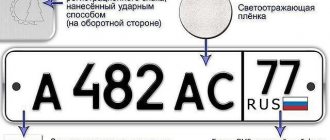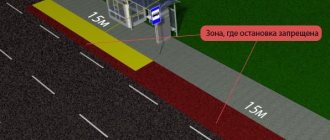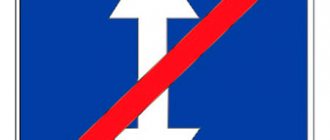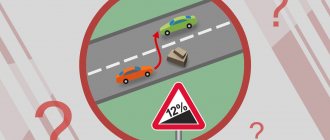Road sign requirements 1.16
The “Rough Road” sign warns motorists of the possible risk of collision with other road users, as well as wear or damage to the vehicle’s suspension.
The first thing the sign requires is to maintain a safe speed. The second is to be ready to go around an obstacle or slow down.
A common mistake made by drivers is to brake sharply in front of a vehicle behind them, which results in a collision. However, in a little-known area or at night, the driver cannot know for sure the road surface.
This is why the installation of sign 1.16 is provided, so that at any moment the steering wheel or braking force can react to an unevenness on the road.
To correct the situation with damage to roads by multi-ton trucks, the legislation of the Russian Federation has introduced a fee per kilometer for heavy trucks over 12 tons. This will keep the roads in good condition according to the meaning of our legislator. Well, we'll wait and see.
Rules for installing a sign 1.16
The unevenness of the road can be associated with undulations, potholes, and not smooth connections with the bridge structure. In this case, in accordance with the provisions of GOST, it is necessary to install warnings.
The “Rough Road” sign is installed immediately in front of the uneven area. If this area is located in the city, then the warning will be valid at a distance of 50-100 meters, outside the city at a distance of 150-300 meters, and also at another distance in accordance with the sign on plate 8.1.1.
When carrying out repair work in the area where the said work is being carried out, there may be uneven roads, about which temporary warning signs 1.16 may be placed before entering. The difference between a permanent sign and a temporary sign will be the change of the sign image to a yellow background, which will be temporary.
The effect of the sign will extend to the nearest intersection; if the road remains uneven, sign 1.16 will be duplicated after the intersection.
In any case, the driver must be warned of the danger, since timely warnings ensure traffic safety for motor vehicles.
Explanation
This sign, installed on the side of the road, warns of various road defects and difficulties that a motorist may encounter: these could be holes, potholes or ruts. Its geometry and colors are standard and characteristic of a warning sign: a white triangle with a red border. The image of the unevenness itself is made in black and somewhat resembles a wave.
Sign 1.16 is set
In a populated area: at a distance of 50-100 meters before the start of a rough road.
Outside the populated area: at a distance of 150-300 meters before the start of a rough road.
Outside the populated area, this sign is installed together with the following signs:
1.25 – Road works.
The sign indicates that road work is being carried out. As a result of road works, the road may be uneven. When installing sign 1.25, sign 1.16 must be on a yellow background.
8.2.1 – Coverage area.
Indicates the length of a dangerous section of the road, in this case an uneven road surface.
Coverage area
It is important for the driver not only to have information about the presence of problem areas on the road, but also to know when to expect them. According to traffic regulations, if a disadvantaged area is located within the city, then the sign is located 50-100 meters before it. Outside the populated area, the “Rough Road” sign is installed at a distance of 150-300 meters. Next to the sign there may be a plate 8.1.1 or 8.2.1 containing other information about the distance to the poor-quality road surface or the length of validity of this sign, respectively.
The effect of the warning sign in question extends to the nearest intersection and is duplicated after it if the road continues to be uneven.
In the event that the irregularities are associated with repair work, a warning sign is also mandatory before entering such an area; it is temporary in nature and is located on a yellow background in combination with warning 1.25 “Road Works”.
Sign 1.16 – “Rough road” with sign 8.2.1 – “Area of action”
If you fall into a hole or hatch, is it an accident or not?
The definition of an accident is enshrined in Article 2 of Federal Law No. 196. Yes, it is also in the traffic rules. But federal laws have much higher priority than decrees of the Government of the Russian Federation. So, according to the norm, a traffic accident does not have to involve a collision of several vehicles and/or injury to people.
But in general, in order for a given incident to be considered an accident, it must include 2 criteria:
- the car participated in the process of road traffic (and stopping and parking are also included in this process),
- there is any material damage, or injuries or deaths as a result of the accident.
The same opinion that getting a car into a deep hole or any other stationary object is considered an accident is also shared by the traffic police department on the official website:
If we're talking about a pothole
A pothole is a type of road irregularity that can also cause an accident. In relation to any potholes and potholes, the same rules apply as for holes and manholes.
It is important to note here that the main criterion for a road accident is any damage – and not only to vehicles. If you did not damage your car as a result of the collision, then there are no signs of an accident. This is important to understand when you are planning to simply drive away from the scene of an accident. And, if with holes and potholes everything is extremely simple, then with a hatch it is more complicated - if, as a result of getting into it, the edging of the hatch is damaged, for example, that is, material damage (it does not matter to whom and whose fault). Therefore, it is prohibited to leave the scene of the accident, otherwise you may lose your license.
Liability for violation of sign 1.16
Administrative legal acts do not provide for penalties for violation of the requirements of sign 1.16. But if the driver ignores the warning measures, it will negatively affect traffic safety. A rut can throw a car into the oncoming lane, which will inevitably cause a collision with an oncoming car.
According to traffic accident statistics, a head-on collision often leads to serious consequences for drivers and passengers. And if there is a truck in the oncoming lane, this can have fatal consequences for the driver who flies into the oncoming lane under the wheels of the truck.
The driver faces a fine for speeding. If he is moving in urban conditions, then his speed should not exceed 60 km/h, outside the city no more than 90 km/h. Unfortunately, road sign 1.16 is not always linked to the speed limit in accordance with the requirements of sign 3.24.
It is advisable to set the speed limit to 40 km/h on rough roads. This will avoid an accident and will be proof that the driver violated the speed limit and ignored the requirements of the road with uneven surfaces.
A common road problem is the appearance of ruts caused by heavy trucks. When you get into a rut, the car becomes difficult to control, especially with wide tires. And if this happens at speed, it can lead to driving into a ditch or into oncoming traffic.
Fines
The “Rough Road” sign, warning about an unfavorable section of the road, first of all, instructs the driver to be especially vigilant and drive at a speed that will allow, if necessary, to brake in time, without resorting to emergency braking.
The legislator has not established administrative liability for ignoring a warning about unevenness on the road, but a careless attitude towards the warning can have a detrimental effect on road safety. It is in the driver's interest to heed warning signs, even if failure to observe them does not directly entail liability, and to be especially careful and slow down whenever possible, because otherwise any rut or other defect in the road surface can lead to serious consequences for the driver, passengers and others. persons
Emergency braking performed at high speed on rough roads can result in the loss of a wheel, muffler, or other serious damage to the vehicle.
Sometimes, in a road work zone, the sign in question complements the established temporary speed limit, but even in this case, the violation will concern the sign that directly obliges the speed limit.
Dodge, unload, do no harm
If you can avoid falling into a hole or puddle, it is better to do so - go around obstacles or reduce your speed to a minimum. At the same time, do not forget that there may be other road users next to or behind you, for whom your maneuvers will likely be unexpected and may provoke an emergency situation. But you are unlikely to have time to think about all this - you will act on reflexes or as you are used to.
A few years ago we made a video on how to properly avoid holes, manholes and other small obstacles. Take a look or review - it won’t hurt before heading out on the spring road
It is for this reason that wheel unloading techniques can be recommended only with the proviso that you know them, you have worked them in safe conditions and can use them effectively and automatically. Otherwise, there may be more harm than good.
If there is no way to slow down or dodge, it is better to drive through the hole in a straight line (if everything happens on an arc, then to do this you need to break the trajectory: turn - straight - turn), with even “gas”. There is a recommendation to sharply increase the gas before a bump, as this will relieve the load on the front wheels. This is all true, but an increase in traction when driving over bumps threatens to result in shock loads on the transmission, and in the case of rear-wheel drive, increases the risk of skidding.
The recommendation to pre-load the front wheels by releasing the “gas” or short braking in front of a pit with active “gas” is then precisely one of those special techniques that require preliminary practice and consolidation of skills. Otherwise, you risk flying into a hole with loaded wheels.
It’s the same story with lateral unloading: you can ease the passage of bumps by rolling in an active turn. But here it is important to build the trajectory correctly, so that the wheel that is inner to the turn is above the hole. Again, you need not only an understanding of the process, but also training, otherwise you can also “mess up.”
Malfunctions caused by poor quality roads
The parts most susceptible to damage from potholes and road obstacles are the suspension and steering components. The chassis, which is in good condition, effectively smooths out unevenness, dampens vibrations and lateral swings of the car body. If the amplitude of vibrations exceeds the value for which shock absorbers and other components are designed, breakdowns occur on the body, which are felt by impacts and characteristic noise. In such a situation, all suspension elements are subjected to increased loads and therefore wear out intensively.
After careless driving on a bumpy road, car owners may experience the following damage to chassis parts:
- delamination and cracking of silent blocks;
- spring sagging;
- shock absorbers leaking;
- wear of hinge joints;
- backlash of steering tips, etc.
Faulty suspension parts must be replaced to avoid damage to interacting elements. You can extend the service life of components and minimize damage if you follow the advice of experienced drivers on driving over uneven road surfaces.











